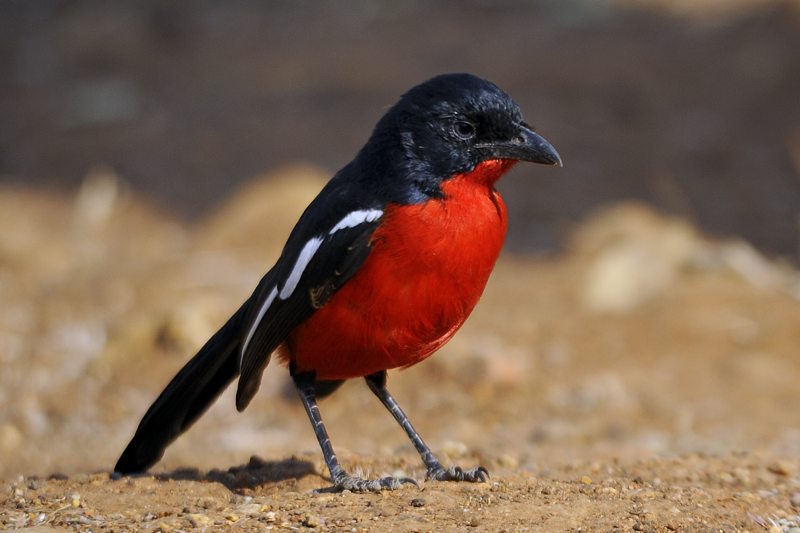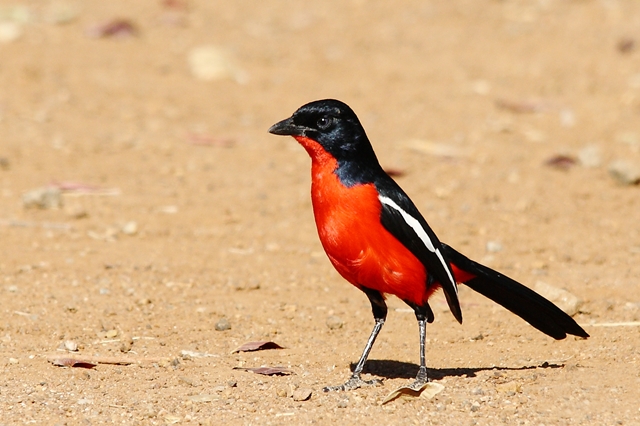
Bushshrikes, Tchagras, Boubous - Family Malaconotidae
Re: Bird Photos - Not Park Specific
An orange-breasted bush-shrike, in focus, badly composed, but nevertheless, a great memory for me


Just be kind - always
-
Klipspringer
- Global Moderator
- Posts: 5862
- Joined: Sat Sep 14, 2013 12:34 pm
- Country: Germany
- Contact:
Bushshrikes, Tchagras, Boubous - Family Malaconotidae
The bushshrikes are smallish passerine birds. They were formerly classed with the true shrikes in the family Laniidae, but are now considered sufficiently distinctive to be separated from that group as the family Malaconotidae.
This is an African group of species which are found in scrub or open woodland. They are similar in habits to shrikes, hunting insects and other small prey from a perch on a bush. Although similar in build to the shrikes, these tend to be either colourful species or largely black; some species are quite secretive.
Some bushshrikes have flamboyant displays. The male puffbacks puff out the loose feathers on their rump and lower back, to look almost ball-like.
These are mainly insectivorous forest or scrub birds. Up to four eggs are laid in a cup nest in a tree.
Taxonomy
Bushshrikes, helmetshrikes (Prionopidae), ioras (Aegithinidae), vangas (Vangidae) and the Australian butcherbirds, magpies and currawongs (Cracticidae) and woodswallows (Artamidae) are part of a large group of shrike-like birds distributed from Africa to Australia, which have been defined as the superfamily Malaconotoidea by Cacraft and colleagues in 2004. Previously, bushshrikes and helmetshrikes have been considered part of the Old World shrike family, Laniidae, based on shared characteristics including a hooked bill. However, analysis of behavioral and molecular characteristics places Malaconotidae closer to Platysteiridae and Vangidae, suggesting that the birds of the family Laniidae are only distant relatives.
Description
Bushshrikes are small to medium-sized passerines, with short, rounded wings and strong legs and feet. Plumage is typically black, grey, and brown, with some yellow and green. Some bush shrikes have red undersides or red throat-patches.
Distribution and habitat
Bushshrikes typically inhabit forest margins or patches of bush in savannah. Some species have been known to inhabit coffee plantations.
Behavior
Laniarius funebris, the slate-colored boubou, mates in monogamous pairs. It has been suggested that songs of this species are triggered more by behavioral cues than by hormone levels.
Bushshrike diets consist mainly of large insects, but occasionally may include wild fruits and berries and sometimes rodents. They catch their prey by gleaning among tree foliage.
Their nests are generally small and neat, and they lay clutches of 2–3 eggs.
Bushshrikes have distinctive harsh or guttural calls, which may be sung as duets. Male and female birds are able to learn songs of similar complexity, and both sexes have similarly-sized repertoire.[9] Songs may be sung to indicate territory or as part of courtship. A 1992 study of the calls of Laniarius funebris found that a male's likelihood of singing a mating song was correlated with his mate's estradiol levels, rather than his own testosterone levels, suggesting that behavioral cues between a mating pair, rather than hormone levels, are most important in triggering mating songs.
List of species in Southern Africa
Malaconotus blanchoti Grey-headed Bushshrike 751
Chlorophoneus nigrifrons Black-fronted Bushshrike 749
Chlorophoneus olivaceus Olive Bushshrike 750
Chlorophoneus sulfureopectus Orange-breasted Bushshrike 748
Telophorus viridis Gorgeous Bushshrike 747
Telophorus quadricolor Four-colored Bushshrike
Telophorus zeylonus Bokmakierie 746
Bocagia minuta Marsh Tchagra, Anchieta's Tchagra 745
Tchagra australis Brown-crowned Tchagra 743
Tchagra tchagra Southern Tchagra 742
Tchagra senegalus Black-crowned Tchagra 744
Dryoscopus cubla Black-backed Puffback 740
Laniarius major Tropical Boubou 737
Laniarius ferrugineus Southern Boubou 736
Laniarius bicolor Swamp Boubou 738
Laniarius atrococcineus Crimson-breasted Shrike, Crimson-breasted Boubou 739
Nilaus afer Brubru 741
This is an African group of species which are found in scrub or open woodland. They are similar in habits to shrikes, hunting insects and other small prey from a perch on a bush. Although similar in build to the shrikes, these tend to be either colourful species or largely black; some species are quite secretive.
Some bushshrikes have flamboyant displays. The male puffbacks puff out the loose feathers on their rump and lower back, to look almost ball-like.
These are mainly insectivorous forest or scrub birds. Up to four eggs are laid in a cup nest in a tree.
Taxonomy
Bushshrikes, helmetshrikes (Prionopidae), ioras (Aegithinidae), vangas (Vangidae) and the Australian butcherbirds, magpies and currawongs (Cracticidae) and woodswallows (Artamidae) are part of a large group of shrike-like birds distributed from Africa to Australia, which have been defined as the superfamily Malaconotoidea by Cacraft and colleagues in 2004. Previously, bushshrikes and helmetshrikes have been considered part of the Old World shrike family, Laniidae, based on shared characteristics including a hooked bill. However, analysis of behavioral and molecular characteristics places Malaconotidae closer to Platysteiridae and Vangidae, suggesting that the birds of the family Laniidae are only distant relatives.
Description
Bushshrikes are small to medium-sized passerines, with short, rounded wings and strong legs and feet. Plumage is typically black, grey, and brown, with some yellow and green. Some bush shrikes have red undersides or red throat-patches.
Distribution and habitat
Bushshrikes typically inhabit forest margins or patches of bush in savannah. Some species have been known to inhabit coffee plantations.
Behavior
Laniarius funebris, the slate-colored boubou, mates in monogamous pairs. It has been suggested that songs of this species are triggered more by behavioral cues than by hormone levels.
Bushshrike diets consist mainly of large insects, but occasionally may include wild fruits and berries and sometimes rodents. They catch their prey by gleaning among tree foliage.
Their nests are generally small and neat, and they lay clutches of 2–3 eggs.
Bushshrikes have distinctive harsh or guttural calls, which may be sung as duets. Male and female birds are able to learn songs of similar complexity, and both sexes have similarly-sized repertoire.[9] Songs may be sung to indicate territory or as part of courtship. A 1992 study of the calls of Laniarius funebris found that a male's likelihood of singing a mating song was correlated with his mate's estradiol levels, rather than his own testosterone levels, suggesting that behavioral cues between a mating pair, rather than hormone levels, are most important in triggering mating songs.
List of species in Southern Africa
Malaconotus blanchoti Grey-headed Bushshrike 751
Chlorophoneus nigrifrons Black-fronted Bushshrike 749
Chlorophoneus olivaceus Olive Bushshrike 750
Chlorophoneus sulfureopectus Orange-breasted Bushshrike 748
Telophorus viridis Gorgeous Bushshrike 747
Telophorus quadricolor Four-colored Bushshrike
Telophorus zeylonus Bokmakierie 746
Bocagia minuta Marsh Tchagra, Anchieta's Tchagra 745
Tchagra australis Brown-crowned Tchagra 743
Tchagra tchagra Southern Tchagra 742
Tchagra senegalus Black-crowned Tchagra 744
Dryoscopus cubla Black-backed Puffback 740
Laniarius major Tropical Boubou 737
Laniarius ferrugineus Southern Boubou 736
Laniarius bicolor Swamp Boubou 738
Laniarius atrococcineus Crimson-breasted Shrike, Crimson-breasted Boubou 739
Nilaus afer Brubru 741
-
Klipspringer
- Global Moderator
- Posts: 5862
- Joined: Sat Sep 14, 2013 12:34 pm
- Country: Germany
- Contact:
- Amoli
- Posts: 6032
- Joined: Fri Jun 01, 2012 4:30 am
- Country: South Africa
- Location: Kempton Park
- Contact:
Re: Shrike - BIRD OF THE MONTH JANUARY 2014
Crimson Breasted Shrike :
POPULATION & DEMOGRAPHY:
Common. In e Botswana, est 2 birds/10 ha, and 1 bird/ha in Okavango Delta
Densities est 1 pair/2.5-7.0 ha (1 pair/4.5 ha, n = 11) at Olifantsfontein, Gauteng and
1 pair/12.5 ha (no n) at Nylsvlei, Limpopo Province.
Oldest ringed bird 8.2 yr.
MOVEMENTS:
Resident and sedentary, but may move locally into riverine woodland during non-br season
HABITAT: Kalahari thornveld, Acacia savanna and semi-arid scrub with scattered clumps of small trees
GENERAL HABITS: Usually in territorial pairs, occasionally singly.
Agile and active, but secretive; constantly changes posture and jerks or swings tail
Territorial pairs counter-sing and interact with excited bowing, side-to-side movements and tail-jerking.
When foraging on ground, has characteristic upright posture, wing tips pointed down and tail held horizontal, jerking up and down with each bounce.
After a few minutes on ground, scampers up through bush, zigzagging from branch to branch until hidden. \
Roosts on mid- to lower branches of thorn tree, especially Sickle-bush Dichrostachys cinerea, 1-4.5 m (av 2.4 m, n = 175) above ground.
Male and female sleep 1 to a few metres from each other, sitting pressed against tree trunk at base of thick branch.
In a 3-year study, 1 pair used 19 roost sites, typically arriving at roost 5-10 min before sunset, leaving 10 min before sunrise in summer, 15-10 min before in winter.
Flight heavy, with shallow wing-beats.
ref : Roberts bird guide
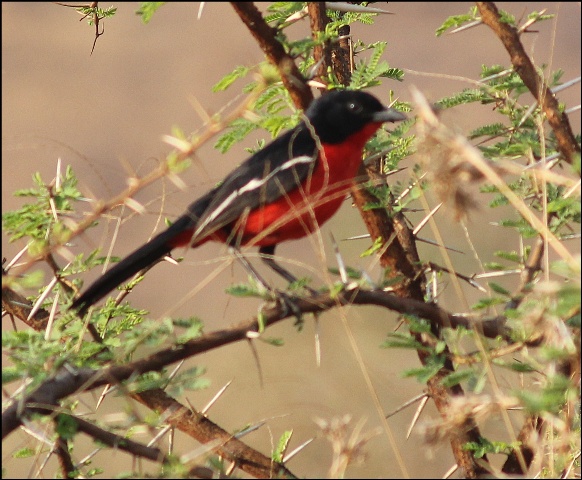

POPULATION & DEMOGRAPHY:
Common. In e Botswana, est 2 birds/10 ha, and 1 bird/ha in Okavango Delta
Densities est 1 pair/2.5-7.0 ha (1 pair/4.5 ha, n = 11) at Olifantsfontein, Gauteng and
1 pair/12.5 ha (no n) at Nylsvlei, Limpopo Province.
Oldest ringed bird 8.2 yr.
MOVEMENTS:
Resident and sedentary, but may move locally into riverine woodland during non-br season
HABITAT: Kalahari thornveld, Acacia savanna and semi-arid scrub with scattered clumps of small trees
GENERAL HABITS: Usually in territorial pairs, occasionally singly.
Agile and active, but secretive; constantly changes posture and jerks or swings tail
Territorial pairs counter-sing and interact with excited bowing, side-to-side movements and tail-jerking.
When foraging on ground, has characteristic upright posture, wing tips pointed down and tail held horizontal, jerking up and down with each bounce.
After a few minutes on ground, scampers up through bush, zigzagging from branch to branch until hidden. \
Roosts on mid- to lower branches of thorn tree, especially Sickle-bush Dichrostachys cinerea, 1-4.5 m (av 2.4 m, n = 175) above ground.
Male and female sleep 1 to a few metres from each other, sitting pressed against tree trunk at base of thick branch.
In a 3-year study, 1 pair used 19 roost sites, typically arriving at roost 5-10 min before sunset, leaving 10 min before sunrise in summer, 15-10 min before in winter.
Flight heavy, with shallow wing-beats.
ref : Roberts bird guide


Pretoriuskop
Satara
Shingwedzi
20-30 Dec 2014
Satara
Shingwedzi
20-30 Dec 2014
Re: Shrike - BIRD OF THE MONTH JANUARY 2014
Dewi
What is the good of having a nice house without a decent planet to put it on? (H D Thoreau)
What is the good of having a nice house without a decent planet to put it on? (H D Thoreau)
Re: Shrike - BIRD OF THE MONTH JANUARY 2014
Laniarius atrococcineus
A bird of the genus Laniarius which was formerly classed with the true shrikes in the family Laniidae, but they and related genera are now considered sufficiently distinctive to be separated from that group as the bush-shrike family Malaconotidae.
One should call it a Crimson-breasted Boubou because it resembles very much its Laniarius brothers, the Southern Boubou and the Tropical Boubou
because it resembles very much its Laniarius brothers, the Southern Boubou and the Tropical Boubou 
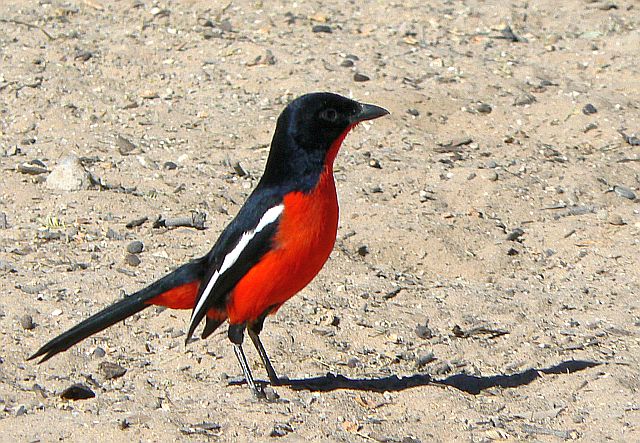
As much as I dislike Nossob camp, I have to admit it's perhaps the best place for Crimson-breasted "Shrike"
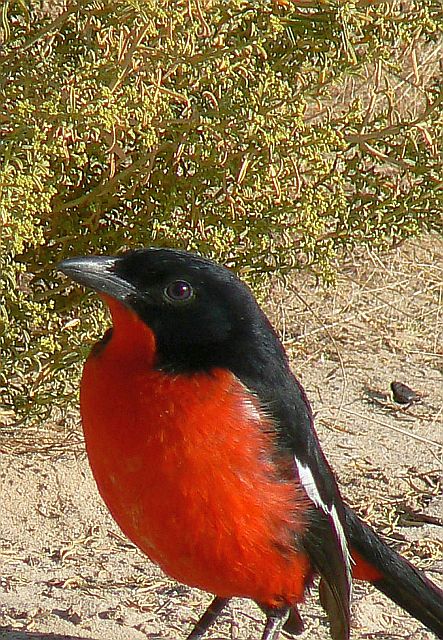
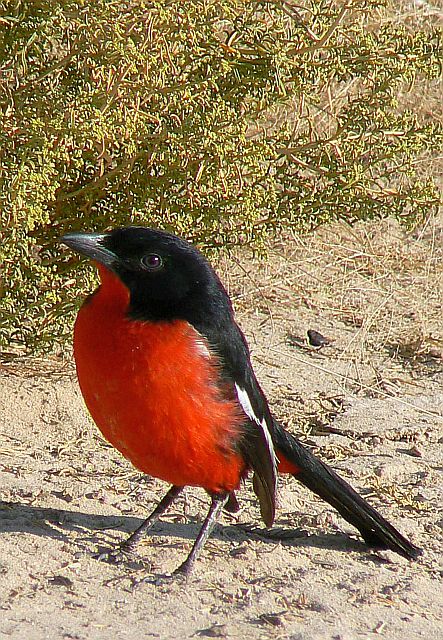
A bird of the genus Laniarius which was formerly classed with the true shrikes in the family Laniidae, but they and related genera are now considered sufficiently distinctive to be separated from that group as the bush-shrike family Malaconotidae.
One should call it a Crimson-breasted Boubou

As much as I dislike Nossob camp, I have to admit it's perhaps the best place for Crimson-breasted "Shrike"


Re: Shrike - BIRD OF THE MONTH JANUARY 2014
Have never seen one outside a camp or picnic spot in KTP 
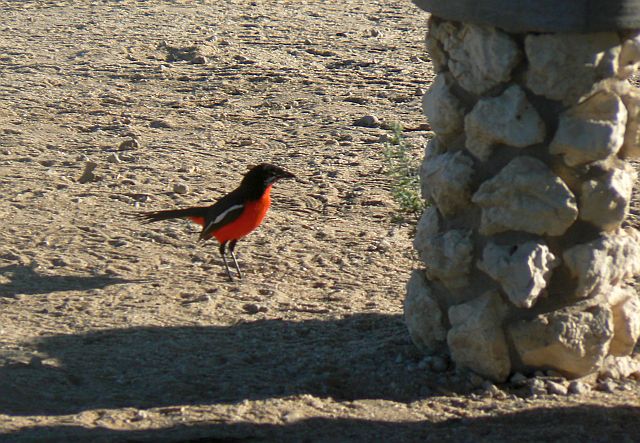
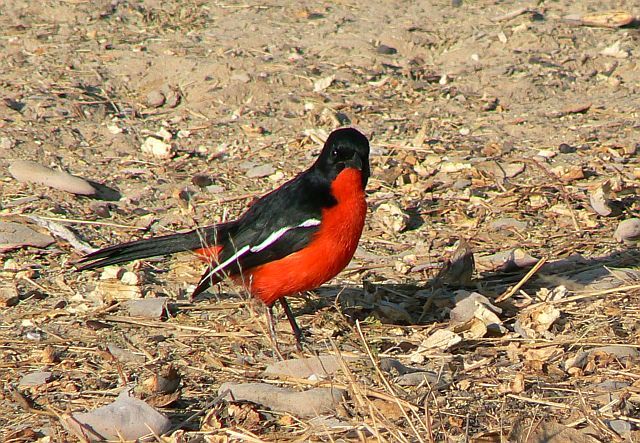

Lijersdraai picnic site



Lijersdraai picnic site
- nan
- Posts: 26350
- Joined: Thu May 31, 2012 9:41 pm
- Country: Switzerland
- Location: Central Europe
- Contact:
Re: Shrike - BIRD OF THE MONTH JANUARY 2014
Kgalagadi 10.9.2009 and 24.9.2012
Crimson-breasted Shrike/Gonolek rouge et noir


Crimson-breasted Shrike/Gonolek rouge et noir


Kgalagadi lover… for ever
https://safrounet.piwigo.com/
https://safrounet.piwigo.com/
Re: Shrike - BIRD OF THE MONTH JANUARY 2014
Sexes are monomorphic with black upperparts to below the eye, black tail and wings showing a white wing stripe. The entire underparts are brilliant crimson except for a yellow morph that occurs occasionally which has lost the ability to transform the yellow food carotinoids into red Astaxanthin based on a gene defect.

Pilanesberg

Pilanesberg




